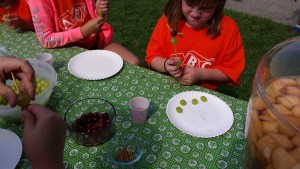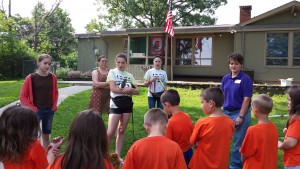As many readers of this newsletter know, Ohio has the dubious distinction of hosting some of the most destructive non-native tree-killing insect pests found in North America. In 2002, emerald ash borer (EAB) was discovered in northwest Ohio. Asian longhorned beetle (ALB) was discovered in and around Bethel, OH, in 2011. Hemlock Woolly Adelgid (HWA) was discovered in eastern Ohio forests in 2012. In 2012, the walnut twig beetle was also detected in Butler County. This bark beetle carries the fungus that causes Thousand Cankers Disease (TCD) and infected black walnut trees were discovered in a landscape in that county in 2013.
Members of our OSU Extension, Hamilton County office have served on the forefront in the battles against these invasive pests since the discovery of EAB in Ohio: Joe Boggs helped to form the “OSU Extension, EAB Outreach Team” in 2002. Unfortunately, it was soon discovered that by the time EAB was found in Michigan, it had already been spread to multiple states by the movement of infested plant material and wood such as fire wood. Sadly, the eradication battle was lost long before EAB was discovered in North America; the beetle can now be found in 26 U.S. states and 2 Canadian provinces. Likewise, HWA is now so widespread including in the Great Smoky Mountains National Park that eliminating this pest from North America will be impossible. TCD may not far behind with sites in many western and eastern states; however, our staff continues to work with the Ohio Department of Agriculture to raise awareness of this killer of black walnut trees. Julie Crook has been distributing outreach materials to the public and Joe has developed a TCD PowerPoint that he uses to teach Green Industry professionals as well as Master Gardeners what to look for with detecting TCD.
While these non-native pests are certainly destructive, they do not come close to the potential devastation that could be caused by ALB should this non-native tree borer be allowed to follow the same pathway of widespread establishment in multiple states. That’s because EAB, HWA, and TCD each focus their destructive attention on just a few tree species. Of course, this may be cold comfort for readers who are suffering through the loss of large ash trees to EAB! However, ash trees belong to a single tree genus; Fraxinus. Just imagine what would happen if a killer of trees belonging to 12 genera were allowed to escape eradication in Ohio and elsewhere in North America. ALB kills all native maples as well as buckeyes/horsechestnuts; elms; willows; sycamore; birches; poplars; Mountainash; and ashes as well as several non-native trees found in Ohio landscapes including mimosa; katsura; and golden raintree. The loss of ash to EAB has been devastating; the loss of trees in 12 genera would be catastrophic. We have never experienced a non-native pest or disease in North America with the destructive capabilities of ALB.
The key to avoiding this grim future rests with discovering and eradicating ALB infestations and early detection is essential to the success of ALB eradication both in terms of time and money. In 2013, Joe and Julie along with several other OSU Extension personnel acquired funding through a USDA Animal and Plant Health Inspection Service (APHIS) Farm Bill grant to develop a standardized ALB training program; the grant was titled “Standardized Asian Longhorned Beetle (ALB) Early Detection Certification Training Programs.” In 2015, Joe was part of another team that acquired USDA APHIS Farm Bill grant funding to use the PowerPoint developed through the first grant as a framework to produce e-learning training modules for the National Plant the National Plant Diagnostic Network (NPDN), First Detector program. The grant is titled, “Asian Longhorned Beetle Detection Education – Training Green Industry Professionals as First Detectors.” There will be eight training modules and the team has completed seven modules; two are currently under peer review through the NPDN. While the exact date for launching the online training has not been set, you can learn more about the NPDN and First Detector training by visiting the following website: https://www.npdn.org/
One of the early challenges discovered with providing ALB outreach training in Greater Cincinnati was the confusion presented by both ALB and EAB overlapping in our region. Indeed, this photo shows dead ash trees that were killed by EAB near Bethel, OH, behind mulch piles produced by grinding-up trees to eradicate ALB. The confusion means that when we say, “ALB,” people often think “EAB,” and vice versa. Both are non-natives originating from Asia; however, they differ in their development, spread, host range, tree killing behavior and most importantly in their management. EAB is well beyond the reach of eradication while ALB infestations can and have been eradicated elsewhere in North America. Readers may reference an article co-authored by Joe in 2013 to learn more about the differences between ALB and EAB. The article appeared in Canadian Groundskeeper (there is an ALB infestation just outside of Toronto) and is still cited by other ALB sources such as under “Resources” on the USDA APHIS website (see below). Here is a direct link to the online version of the article:
http://www.kenilworth.com/publications/cg/de/201311/files/19.html
Our office staff have long been engaged in the fight against non-native invasives, but you can help too! To learn more about ALB and to report a suspicious tree or beetle, visit the USDA APHIS ALB website at:
http://asianlonghornedbeetle.com/








